Chapter 4 - Large-Scale Digitization at The National Archives
Published online by Cambridge University Press: 20 November 2020
Summary
THE NATIONAL ARCHIVES is the repository of the official record of the government of England and Wales. It holds records from all government departments dating back to the eleventh century. There are government documents in other collections, from a time when ministers kept their papers when they left their government role, but from 1838 when the first Public Records Office Act was created, records created for government business belonged to government. From that date, and through further permutations of the Act, The National Archives (TNA) and its previous incarnations have retained the official record of government.
The Public Records Act governs, among other things, the statutory functions of preservation and access to government records, and digitization is a key tool for both as well as vital revenue generation. This chapter focuses on mass commercial digitization of collections, rather than individual record capture for researchers in our reading rooms.
Surrogate Production and Data Creation
TNA holds over 220 kilometres of government history at the time of writing, an amount that increases each year as more records are opened by the government under transparency legislation, which dictates that records are opened to the public after a twenty-year period. Records are stored both on-site and at an off-site facility. Any open record can be requested for digitization, and the collections are valuable for both academic and family history research.
Digitization is an expensive, resource-intensive process, with multiple complex work streams surrounding the image capture itself to create the final digital product. The record sets at The National Archives are rarely consistent; media, condition, size, colour, and format of individual documents can vary greatly even within the same volume or file. Additionally, client requirements vary, so solutions to each work stream must be tailored to each project.
The National Archives has created surrogates from original documents since the 1960s using microfilm and began creating digitized records from its own collection of microfilm in the early 2000s, the largest of which was the 1901 census released in January 2002.
- Type
- Chapter
- Information
- Book Conservation and DigitizationThe Challenges of Dialogue and Collaboration, pp. 97 - 104Publisher: Amsterdam University PressPrint publication year: 2020



